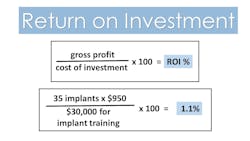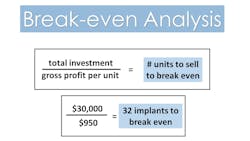How do you know if you should spend money on a new technology? When will new technology be a sound investment and when will it be a complete waste of money?
Good news! You don’t have to rely on your gut instincts for these important decisions. There are two equations that dentists can entertain before breaking out the checkbooks.
Let’s say you are considering placing implants in your practice. First, add up all of your costs to get up and running. You’ll need to take a hands-on workshop, buy some surgical equipment, and stock an inventory of implants. For our purposes, I’ll say that comes to $30,000 in total investment. Now it’s time to break out the equations.
For this equation, you need to estimate how much new gross profit you’ll make in a certain time period, typically one year. Gross profit is simply the cash left over after direct materials and labor from your fee are subtracted. (For more information, check out this DE article I wrote on gross profit.) So, if you guess you’ll place 35 implants this year, multiplied by $950 profit per implant, that means you’ll expect to generate $33,250 in additional gross profit this year. Divide that by the total investment cost, multiply by 100, and this is the ROI as a percentage. As long as this number is positive, then it’s a good financial investment. If it’s negative, that means you’ll be losing money in that time period.
The ROI calculation is great for comparing investments. For example, if you were considering placing implants versus doing more endodontics (taking courses, buying rotary handpieces, etc.), you could run the ROI numbers for both and see which strategy is a better financial decision. The calculation with a higher positive percentage is, from a financial perspective, a better return on investment.
Another calculation to consider is break-even analysis. This estimates how long it will take to make back the money spent on the investment. For this formula you’ll need to estimate how much gross profit you make per procedure. Take your fee and subtract your material and labor costs for each implant. Divide your total investment by this gross profit number and you’ll learn how many implants you have to place until you make money.
Keep in mind two important factors. First, this is just an estimate! Don’t sweat being $100 accurate in estimating your costs and revenue, just be consistent between calculations. Second, there’s more that goes into the buying decision than just these financial considerations. Technology can help you improve efficiency, increase case acceptance, “wow” patients, and offer other benefits that don’t fit into equations. These calculations are just part of the strategy.
If you’re interested in learning more about how cash moves through your business (and where it leaks or gets stuck) then I recommend coming to Las Vegas this June 25–26 for the Dental Economics Profit Summit. I’ll be lecturing in-depth on ROI and I’ll be joined by thought leaders from across the profession. If you’re specifically considering investing in digital impressions and/or CAD/CAM, I’ll be presenting in Charleston March 12_13 for the Comprehensive Digital Dental Alliance conference.
We are practicing during the Third Industrial Revolution. Technology is radically transforming industries, including our profession. Hopefully these calculations will help you determine which technology makes sense for your practice and when it’s time to pull the trigger.
Cheers,
Chris
Chris Salierno, DDS, is the chief editor of Dental Economics and the editorial director of the Principles of Practice Management e-newsletter. He is also a contributing author for DentistryIQ and Perio-Implant Advisory. He lectures and writes about practice management and clinical dentistry. Additional content is available on his blog for dentists at thecuriousdentist.com. Dr. Salierno maintains a private general practice in Melville, New York. You may contact him by e-mail at [email protected].
About the Author

Chris Salierno, DDS
Chief Editor, Dental Economics
Chris Salierno, DDS, is the chief editor of Dental Economics and the editorial director of the Principles of Practice Management and Group Practice and DSO Digest e-newsletters. He is also a contributing author for DentistryIQ and Perio-Implant Advisory. He lectures and writes about practice management and clinical dentistry. He maintains a blog to answer patient questions at ToothQuest. Dr. Salierno maintains a private general practice in Melville, New York. You may contact him at [email protected].
Updated Dec. 4, 2020


